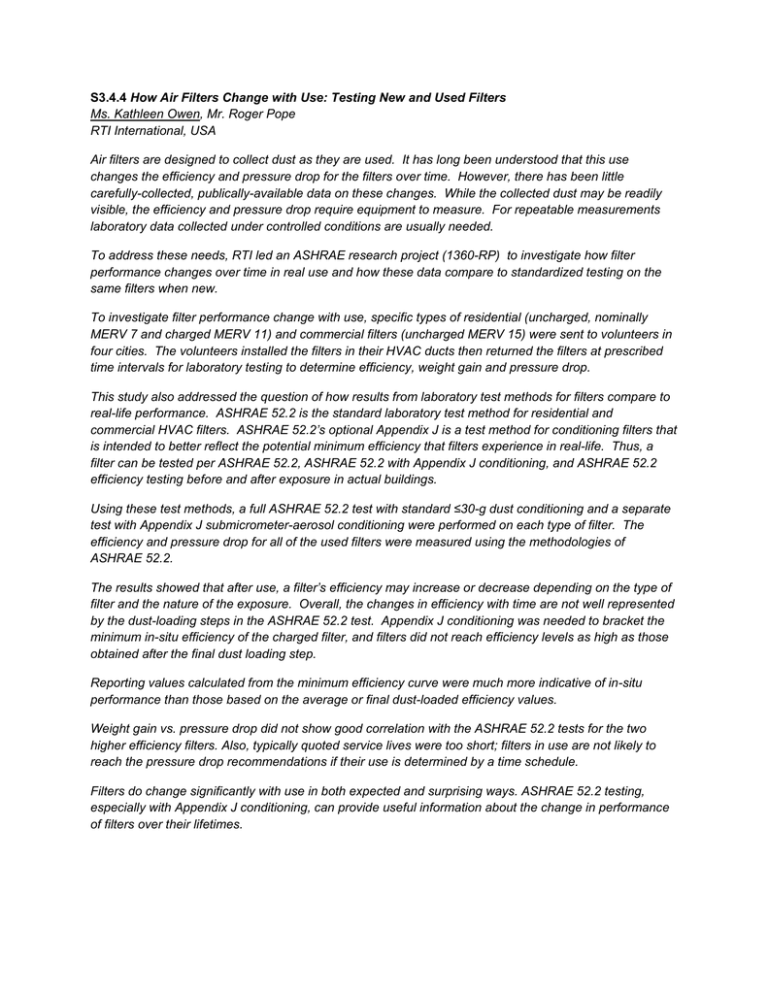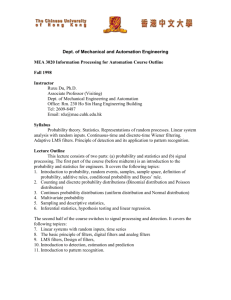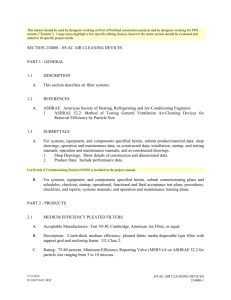S3.4.4 Ms. Kathleen Owen, Mr. Roger Pope RTI International, USA
advertisement

S3.4.4 How Air Filters Change with Use: Testing New and Used Filters Ms. Kathleen Owen, Mr. Roger Pope RTI International, USA Air filters are designed to collect dust as they are used. It has long been understood that this use changes the efficiency and pressure drop for the filters over time. However, there has been little carefully-collected, publically-available data on these changes. While the collected dust may be readily visible, the efficiency and pressure drop require equipment to measure. For repeatable measurements laboratory data collected under controlled conditions are usually needed. To address these needs, RTI led an ASHRAE research project (1360-RP) to investigate how filter performance changes over time in real use and how these data compare to standardized testing on the same filters when new. To investigate filter performance change with use, specific types of residential (uncharged, nominally MERV 7 and charged MERV 11) and commercial filters (uncharged MERV 15) were sent to volunteers in four cities. The volunteers installed the filters in their HVAC ducts then returned the filters at prescribed time intervals for laboratory testing to determine efficiency, weight gain and pressure drop. This study also addressed the question of how results from laboratory test methods for filters compare to real-life performance. ASHRAE 52.2 is the standard laboratory test method for residential and commercial HVAC filters. ASHRAE 52.2’s optional Appendix J is a test method for conditioning filters that is intended to better reflect the potential minimum efficiency that filters experience in real-life. Thus, a filter can be tested per ASHRAE 52.2, ASHRAE 52.2 with Appendix J conditioning, and ASHRAE 52.2 efficiency testing before and after exposure in actual buildings. Using these test methods, a full ASHRAE 52.2 test with standard ≤30-g dust conditioning and a separate test with Appendix J submicrometer-aerosol conditioning were performed on each type of filter. The efficiency and pressure drop for all of the used filters were measured using the methodologies of ASHRAE 52.2. The results showed that after use, a filter’s efficiency may increase or decrease depending on the type of filter and the nature of the exposure. Overall, the changes in efficiency with time are not well represented by the dust-loading steps in the ASHRAE 52.2 test. Appendix J conditioning was needed to bracket the minimum in-situ efficiency of the charged filter, and filters did not reach efficiency levels as high as those obtained after the final dust loading step. Reporting values calculated from the minimum efficiency curve were much more indicative of in-situ performance than those based on the average or final dust-loaded efficiency values. Weight gain vs. pressure drop did not show good correlation with the ASHRAE 52.2 tests for the two higher efficiency filters. Also, typically quoted service lives were too short; filters in use are not likely to reach the pressure drop recommendations if their use is determined by a time schedule. Filters do change significantly with use in both expected and surprising ways. ASHRAE 52.2 testing, especially with Appendix J conditioning, can provide useful information about the change in performance of filters over their lifetimes.





